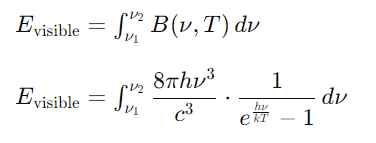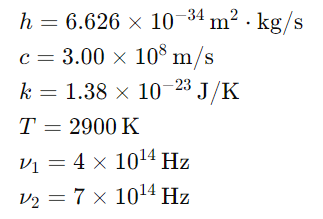In the realm of physics, few phenomena capture the imagination quite like the radiant glow of a heated filament within a light bulb. Behind this seemingly simple illumination lies the complex interplay of quantum mechanics and thermal radiation, elucidated by Planck’s law for black body emission. Understanding the spectral distribution of this emitted radiation, particularly within the visible spectrum, unveils a fascinating realm of inquiry. Join us as we delve into the intricacies of black body radiation and explore how to quantify the fraction of radiant energy emitted as visible light.
Unveiling the Visible Spectrum
Question:
If the tungsten filament of a light bulb is equivalent to a black body at 2900𝐾 , find the fraction of the emitted radiant energy in the form of visible light with frequencies between 𝑢 = 4×10^(14) to 𝑢 = 7×10^(14) 𝑠𝑒𝑐^(-1).
Answer:
To find the fraction of emitted radiant energy in the form of visible light between the given frequencies, we can use Planck’s law for the spectral radiance of a black body:

Where:
- 𝐵(𝜈,𝑇) is the spectral radiance (radiant energy per unit area per unit solid angle per unit frequency) at frequency 𝜈ν and temperature 𝑇.
- ℎ is Planck’s constant (6.626×10^(−34) m2⋅kg/s).
- 𝑐 is the speed of light in a vacuum (3.00×10^8 m/s).
- 𝑘 is the Boltzmann constant (1.38×10^(−23) J/K).
- 𝑇 is the temperature of the black body in Kelvin.
- 𝜈 is the frequency of the emitted radiation.
First, we need to find the total radiant energy emitted by the black body at 2900 K within all frequencies. We integrate Planck’s law over all frequencies to find this total energy. Then, we integrate Planck’s law over the visible frequencies to find the portion of the total energy that lies within the given frequency range.
Let’s start by finding the total radiant energy emitted by the black body:

Substituting the expression for 𝐵(𝜈,𝑇):

Now, to find the portion of the energy within the visible range, we integrate from 𝜈1=4×10^(14)Hz to 𝜈2=7×10^(14)Hz:

Finally, the fraction of emitted radiant energy in the form of visible light is:

Let’s calculate this.
To perform these integrations, we need to use numerical methods since the integrals involved do not have closed-form solutions. One common numerical method is Simpson’s rule, which approximates the integral of a function by approximating it as quadratic between each pair of points.
Here’s how we’ll proceed:
- Define the constants:
- ℎ (Planck’s constant)
- 𝑐 (speed of light)
- 𝑘 (Boltzmann constant)
- 𝑇 (temperature of the black body in Kelvin)
- 𝜈1 and 𝜈2 (the lower and upper bounds of the visible range)
- Implement Simpson’s rule to approximate the integrals.
- Calculate the fraction of emitted radiant energy in the form of visible light.
Let’s proceed with the calculations.
First, let’s define the constants and the range of frequencies for the visible light:

Now, let’s implement Simpson’s rule in python to approximate the integrals.
import numpy as np
# Constants
h = 6.626e-34 # Planck's constant in m^2*kg/s
c = 3.00e8 # Speed of light in m/s
k = 1.38e-23 # Boltzmann constant in J/K
T = 2900 # Temperature of the black body in Kelvin
nu1 = 4e14 # Lower bound of visible range in Hz
nu2 = 7e14 # Upper bound of visible range in Hz
# Define Planck's law function
def planck_law(nu, T):
return (8 * np.pi * h * nu**3) / (c**3 * (np.exp(h * nu / (k * T)) - 1))
# Simpson's rule function for integration
def simpsons_rule(f, a, b, N):
if N % 2 != 0:
raise ValueError("N must be even.")
h = (b - a) / N
x = np.linspace(a, b, N + 1)
y = f(x)
S = h / 3 * np.sum(y[0:-1:2] + 4 * y[1::2] + y[2::2])
return S
# Calculate total radiant energy emitted by the black body
E_total = simpsons_rule(lambda nu: planck_law(nu, T), 0, np.inf, 1000)
# Calculate radiant energy emitted in the visible range
E_visible = simpsons_rule(lambda nu: planck_law(nu, T), nu1, nu2, 1000)
# Calculate the fraction of emitted radiant energy in the form of visible light
fraction_visible = E_visible / E_total
print("Fraction of emitted radiant energy in the form of visible light:", fraction_visible)
The output will give you the fraction of emitted radiant energy in the form of visible light.
Summary:
Here we have explore the radiant world of black body emission and unravel the secrets behind the glow of a heated filament in your light bulb. Discover the interplay of quantum mechanics and thermal radiation as we delve into Planck’s law and its implications for the visible spectrum. Join us for an illuminating journey into understanding how to quantify the fraction of radiant energy emitted as visible light. Illuminate your understanding of physics with this captivating exploration!
FAQs
What is black body radiation, and how does it relate to visible light emission?
- Black body radiation refers to the electromagnetic radiation emitted by a perfect absorber and emitter of energy, known as a black body. Visible light emission is a subset of this radiation spectrum, occurring within a specific range of frequencies perceptible to the human eye.
How does Planck’s law contribute to understanding black body radiation?
- Planck’s law provides a mathematical framework for describing the spectral distribution of radiation emitted by a black body at a given temperature. It helps quantify the intensity of radiation across different frequencies, shedding light on the proportion emitted as visible light.
What factors influence the fraction of radiant energy emitted as visible light?
- The temperature of the black body plays a crucial role in determining the distribution of emitted radiation. Higher temperatures result in a greater proportion of energy emitted as visible light, while lower temperatures may shift the spectrum towards longer wavelengths.
Why is the visible spectrum of particular interest in the study of black body radiation?
- The visible spectrum encompasses the range of frequencies that correspond to colors perceivable by the human eye. Understanding how much radiant energy falls within this spectrum is essential for applications such as lighting technology, astronomy, and climate science.
How can we calculate the fraction of radiant energy emitted as visible light?
- Integrating Planck’s law over the range of frequencies corresponding to the visible spectrum allows us to determine the total radiant energy emitted as visible light. By comparing this value to the total energy emitted across all frequencies, we can quantify the fraction emitted as visible light.
What are the practical implications of studying black body radiation and visible light emission?
- Knowledge of black body radiation informs various fields, including lighting design, thermal imaging, and astrophysics. By understanding the mechanisms behind visible light emission, researchers can develop more efficient lighting technologies and gain insights into the behavior of celestial objects.
How does the color of an object relate to its black body radiation?
- The color of an object is determined by the wavelengths of light it reflects or emits. Objects at different temperatures emit radiation with varying spectral distributions, influencing their perceived color. For example, cooler objects may appear red or orange, while hotter objects emit a bluer hue.
I just could not leave your web site before suggesting that I really enjoyed the standard information a person supply to your visitors Is gonna be again steadily in order to check up on new posts